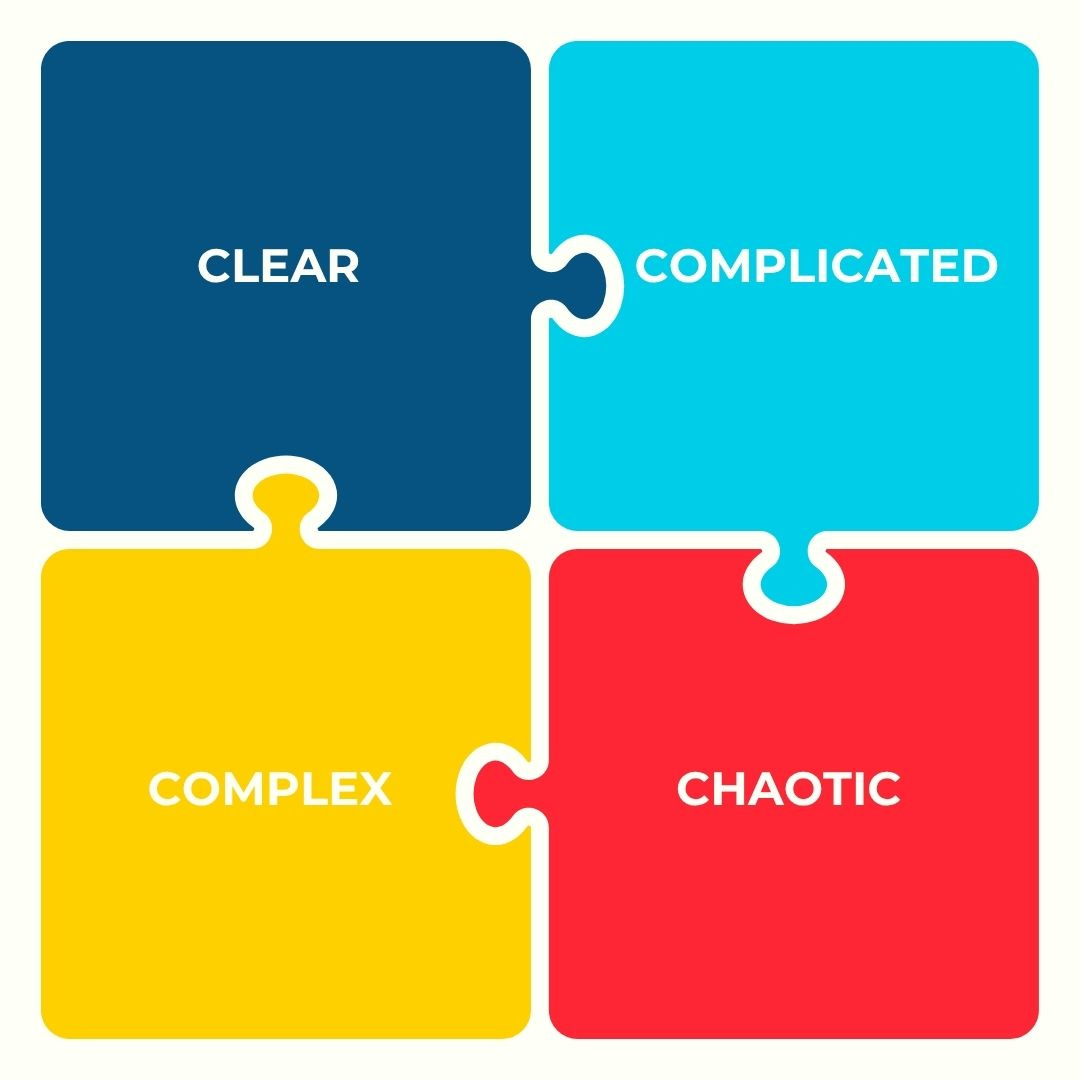Change Fatigue. How to recognise and overcome it in a VUCA world
Change fatigue is a growing problem in organisations. Learn what it is, how to recognise it, and proven ways to overcome change fatigue using VUCA and Cynefin.
Change. Again?
Another system upgrade. Another “transformation.” Another announcement that the strategy has changed.
If you feel like your organisation is constantly shifting gears without ever really getting anywhere, you’re not alone. And if your people seem weary, disengaged or quietly rolling their eyes at the mention of the next big initiative, you might be facing something deeper than frustration. You’re likely seeing the signs of change fatigue.
Let’s explore what change fatigue really is, how to recognise it, what causes it and — most importantly — how to manage and prevent it using practical strategies, real-world insight, and proven frameworks like VUCA and Cynefin.
What Is Change Fatigue?
Change fatigue is a state of psychological, emotional, and sometimes physical exhaustion caused by ongoing organisational change and constant transformations. When people experience too much change, or too many poorly managed changes, they can lose motivation, stop engaging, or even begin actively resisting. It’s the burnout that comes not just from doing too much, but from being pulled in too many directions — without clarity, support or visible success.
Why Change Fatigue Is Becoming More Common
Welcome to the VUCA World
The term VUCA came from the US military to describe the messy, unpredictable world after the Cold War. We live in a VUCA environment — short for:
Volatile – Things can change quickly and unpredictably. (e.g. market crashes, tech disruption)
Uncertain – We often don’t have all the information we need to make confident decisions. (e.g. during a pandemic)
Complex – There are lots of interconnected parts, and changing one thing affects everything else. (e.g. global supply chains)
Ambiguous – Sometimes, it’s hard to even know what’s going on, let alone what to do about it. (e.g. hybrid work culture)
Sound familiar?
Take the COVID pandemic, for example. In early 2020, businesses everywhere were reacting to new information daily. Restrictions changed. Supply chains collapsed. Everyone was suddenly working from home. Decisions had to be made fast, often without much clarity.
Or think about a bank rolling out a new customer platform. They’re not just switching software — they’re dealing with legacy systems, compliance requirements, staff training, customer expectations, and reputational risk. One small change in one team can ripple across the entire business. That’s complexity in action.
In a VUCA world, change isn’t something you plan for every five years. It’s something you manage all the time. And that’s where things get tricky.
Making Sense With Cynefin
To help us figure out how to respond to all this unpredictability, let’s look at the Cynefin framework (pronounced “kuh-nev-in”). It’s a sense-making model and helps leaders decide what type of approach to take depending on the nature of the situation.
Cynefin breaks things down into four domains:
1. Clear
Characteristics: Obvious cause and effect (e.g. following a checklist). Situation is well understood.
Best Approach: Use best practice
2. Complicated
Characteristics: Relationship between cause and effect requires analysis or expertise as there is often many solutions (e.g. upgrading payroll systems)
Best Approach: Bring in specialists
3. Complex
Characteristics: Cause and effect only clear in hindsight. There are many unknown elements (e.g. cultural change)
Best Approach: Test, learn, adapt
4. Chaotic
Characteristics: The relationship between cause and effect are highly unknown and changeable. Immediate action is needed (e.g. data breach) but the results are unpredictable
Best Approach: Stabilise quickly
The Cynefin Framework was created by Dave Snowden and helps leaders understand the context to support decision making.
Most organisational change efforts fall into the complex domain, where traditional linear planning doesn’t work. Instead, success depends on learning and adjusting. But without the right mindset and support, complex change leads to confusion, frustration and fatigue.
How to Know If Your Team Has Change Fatigue
Wondering whether your people are quietly suffering from change fatigue? Here are the signs to watch for:
Top Signs of Change Fatigue in the Workplace
Cynicism and sarcasm about change efforts (“Here we go again…”)
Disengagement – staff showing up but mentally checking out
Increased turnover, particularly among high performers
Change resistance – not overt refusal, just silence and inaction
Low trust in leadership and past change efforts
Burnout symptoms – stress, fatigue, absenteeism
If your surveys are showing low morale, and your people are showing low energy, it’s worth asking: are we pushing through too much change without enough support?
10 Ways to Overcome and Prevent Change Fatigue
The good news? Change fatigue is reversible. Here’s how to rebuild energy, engagement, and trust.
1. Pause and Prioritise
You don’t need to deliver every change at once. Take stock of what’s already happening and look for areas of overlap, duplication or confusion. Trim what isn’t adding value.
2. Sequence Change Thoughtfully
Space out change where possible. Avoid back-to-back launches or clashing timeframes. Use a change calendar or roadmap so people can mentally prepare and plan.
3. Clarify the 'Why'
Start every change with a clear, simple explanation of the reason behind it. Link the change to broader goals or problems people care about. Repeat this message often.
4. Be Honest About the Impact
Acknowledge that change is hard. Be transparent about what's known, what’s still being worked out, and what it will realistically take. People appreciate honesty over hype.
5. Make Space for Recovery
Schedule downtime after major initiatives. That might mean fewer meetings, blocked out quiet time or pausing other initiatives temporarily. Change absorption needs time.
6. Involve People in Shaping the Change
Bring staff into the design process early. Ask for feedback and input before rolling things out. Involvement builds trust and commitment.
7. Equip Leaders and Managers
Managers are your most important change agents. Train them in change leadership, emotional intelligence and how to support teams through uncertainty.
8. Tell Stories and Share Success
Celebrate real progress, not just end goals. Share stories of what’s working and highlight how individuals are making a difference. This builds belief in the change.
9. Focus on Wellbeing and Support
Offer genuine wellbeing support — not just lip service. That could include flexible work options, mental health resources, peer coaching or resilience-building programs.
10. Track Sentiment and Listen
Use feedback tools, skip-level conversations or quick pulse checks to understand how people are coping. Then act on what you learn, visibly and quickly.
Then — and this part matters — act on what you hear.
Change With People, Not At Them
Change fatigue is not a sign of resistance. It’s a signal that your people are overwhelmed, under-supported or unconvinced. That’s not a failure. It’s an opportunity to lead differently.
When organisations slow down, communicate clearly, and genuinely listen, change can stop being something people dread — and start being something they shape and own.
Because people don’t fear change itself. They fear being left out of it.
When they feel respected, informed, and involved, they don’t resist change — they drive it.
Want Help Embedding Change Without Fatigue?
Whether you’re a people leader, HR partner, product leader or change professional, you don’t have to navigate this alone. Reach out for support, workshops, or tools to build a healthier, more resilient change culture in your team.
FAQs:
Q: What is change fatigue in the workplace?
A: Change fatigue is the psychological exhaustion that employees feel when exposed to continuous organisational change. It often results in disengagement, low morale, and reduced productivity.
Q: What does VUCA stand for?
A: VUCA stands for Volatile, Uncertain, Complex, and Ambiguous. It describes environments where change happens rapidly, outcomes are unpredictable, problems are interconnected, and there is no clear path forward. It is often used to explain the modern challenges organisations face in decision-making and strategy.
Q: What is the Cynefin framework?
A: The Cynefin framework is a decision-making model that helps leaders understand different types of situations and choose the right approach. It includes five domains: Clear (simple problems), Complicated (expert analysis needed), Complex (emergent solutions), Chaotic (urgent action), and Confused (unclear situation). It supports better leadership in uncertain environments.
Q: What is the difference between VUCA and Cynefin?
A: VUCA describes the nature of the environment — volatile, uncertain, complex, and ambiguous. Cynefin is a framework used to make sense of that environment and decide how to act. VUCA explains the challenge, while Cynefin guides the response.
Q: When to use VUCA?
A:Use VUCA when you need to:
Explain why things feel unstable or unpredictable.
Align leadership or teams around the reality of operating in a turbulent environment.
Set the stage for why a new leadership, strategy or change approach is needed.
Acknowledge that traditional planning and control won’t work in the current climate.
For example: A global HR team is developing a future workforce strategy. They use VUCA to describe challenges like automation, geopolitical shifts, and changing employee expectations. This helps build a case for agility, not just another 5-year plan.
Q: When to use Cynefin?
Use Cynefin when you need to:
Analyse the type of change or decision you’re facing.
Choose the right leadership or problem-solving approach (e.g. best practice vs experimentation).
Avoid misapplying simple solutions to complex problems.
Train leaders to navigate ambiguity with confidence.
For example: A change team is rolling out a new values-led culture across a national healthcare provider. They use Cynefin to frame the change as complex, meaning they’ll need small pilots, feedback loops, and emergent outcomes — rather than a top-down comms plan and checklist.
Q. How to use VUCA and Cynefin Together?
Think of them as two lenses:
VUCA helps you see the landscape (where are we and why is it so challenging?).
Cynefin helps you navigate the terrain (what kind of problem are we facing, and how should we respond?).
Example: You're leading a transformation in a government agency facing shifting regulations, public scrutiny, and digital disruption. You:
Use VUCA to explain the chaotic and uncertain operating environment to executives.
Use Cynefin to help change teams and managers understand that some elements of the transformation (like tech systems) are complicated, while others (like behaviour change) are complex — and need different strategies.
I’m Irene Liakos. A product transformation expert with over 2 decades of experience growing product profitably across Telco, Banking, Fintech, AI, Data, Travel, Ecommerce and more. I teach, coach and advise product managers and business leaders. Reach out to me if your products aren’t delivering the value you need for your business to grow. You can contact me at irene@phronesisadvisory.com
Are you new to Product Management and want to learn from me?
I created a Course. For people new to Product Management.
Aligned it with the Learning Outcomes created by Product greats like Jeff Patton and others. Had it certified by the globally recognised ICAgile.
Choose to spend 2 days learning from me - either face to face or via Zoom - with ICAgile Certified Professional in Product Management (ICP-PDM).
And if you’re looking for a sneaky discount, send me an email at irene@phronesisadvisory.com



